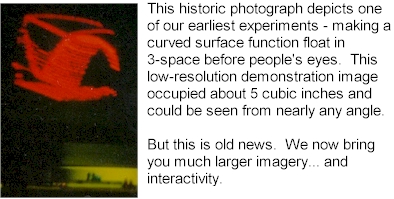
Swept volumetric imaging techniques (abbreviated "SVIT"'s here, for convenience) work in a way that is similar to a very advanced flip book. In SVIT's, a series of two-dimensional images that varies over time is projected onto a plane, which is then swept out over a volume of space at a frequency higher than the eye can resolve. In simple terms, the SVIT system figures out which points of the 3D object would lie on each point in space and, as the plane spins, the system projects the correct points onto the spinning plane Our vision reconciles the rapidly-moving two-dimensional images as a coherent three-dimensional image, just like in a flip book.
A good example of a SVIT can be found in Becton Lab at Yale
University, on display across from the elevators on the basement
floor. The SVIT on display there was designed by Gregg Favalora as
his senior project at Yale, and it projects laser images onto a
rapidly rotating cylindrical surface. Gregg is now working for
Actuality Systems,
Inc., and, as he says, "our recent stuff is secret." The image and
text below are from the commercial portion of their page.

|
| ||
BACK |
|
NEXT |